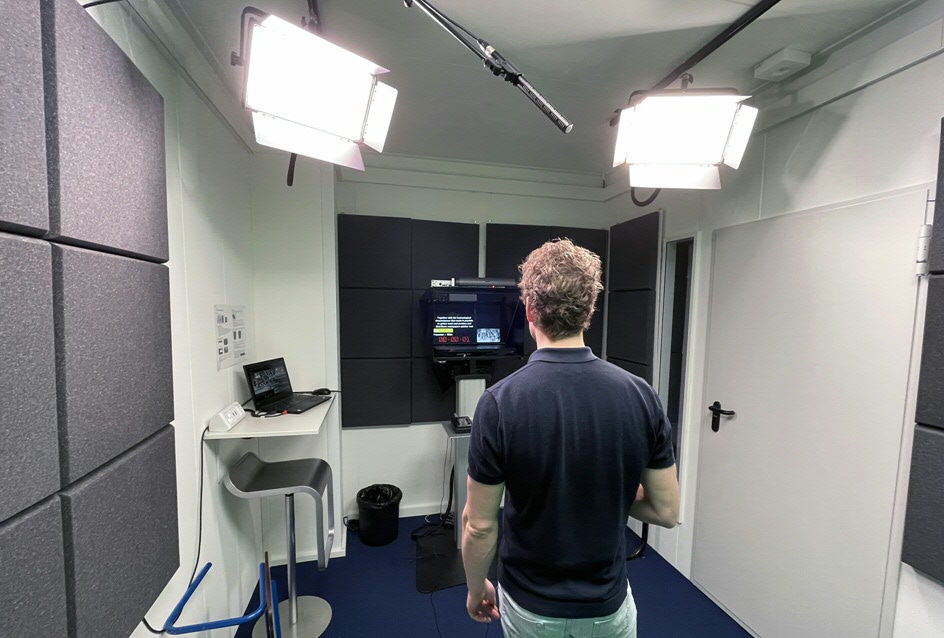Making knowledge clips in the DIY Studio

Why would you need a DIY studio?
A long time ago now, I first saw the announcement that the Harmonie building was about to host a Do It Yourself (DIY) Studio, but I had no conception of what this was and never thought that the studio would be such a lifesaver for me. The build-up to the academic year 2020-2021 was full of uncertainty. Would we be able to teach physical classes at all? Would we teach entirely online or make use of a hybrid form of teaching? I felt that the uncertainty was getting to the students as much as to me and so I made the decision in early August 2020 to teach entirely online and looked for ways in which this could be realized most optimally.
With two courses in block 1 that have quite a traditional set-up of two lecture and two seminar hours per week, I would in previous years always start the week going over the most important (theoretical) concepts, allowing students plenty of time to ask questions and then the rest of the week would be spent working with the materials to reach a better understanding of the topics. With the switch to online teaching I wanted to make the same content available but in bite-sized chunks, and the DIY studio not only proved vital in doing that but also allowed for a restructuring of the courses that improved the content and student engagement with the course materials in important ways.

The studio itself and how it works
The DIY studio is a space on the second floor of the Harmonie building (located directly opposite the AV Services desk). The studio itself looks very professional, with a green screen, sound-attenuated booth, and microphones and lighting spots hanging from the ceiling. There is also a laptop in the room and, of course, a camera that is integrated in an apparatus that projects your slides on the right while presenting you with an autocue that runs across the camera so that you always directly face the camera when reading your script.
When preparing to record in the studio, it is a good idea to watch the tutorial first. The use of the studio is very intuitive and within 5 minutes of being shown the ropes by the very savvy and helpful AV Services staff you’re making your first recording. The first step is preparing your powerpoint presentation and adding a script per slide, which forms the autocue during the recording. Once prepared, you bring the ppt on a USB stick to the studio and select - for each slide indivually - whether you want the recording to show you and the slide, only the slide or only you as a presenter. You then take your place on the footsteps provided for you on the floor, and start the recording. When finished, you wait some time before the video is saved onto the USB stick and you are then free to upload the video onto, for instance, Nestor using the P2Go option.
My experience – corroborated by feedback from students – is that the sound and video quality of the DIY recordings are excellent and contrast starkly to what you can do in your own home (unless you have professional recording equipment). In the face of students not always having optimal internet connections, video and sound quality become even more vital. The studio is so easy to use and you do not have to be tech savvy to be able to produce professional looking videos very quickly and easily.
Asynchronous (over)learning opportunities
While it is perfectly fine to plan all of the videos you wish to record in advance, due to time constraints before the course started I didn’t have time to prepare all of my 7 weeks in advance. Instead, I booked a weekly 2-hour slot in the studio. I would prepare a brief (no more than 3 minutes) introduction to each week, briefly recapping the previous week and looking ahead by means of that week’s learning aims. This brief video would mark the start of the students’ week as well. This set-up allows you to critically look at your course: what do I really want my students to take away from this particular week? What do they need to know and be able to do by the end of it?
Based on these learning aims, I critically examined the lecture materials and slides from previous years and cut each week up into subtopics and prepared brief knowledge clips based on those topics. I then recorded these knowledge clips. Although they were occasionally longer, I tried to aim for knowledge clips of no more than 10 to 12 minutes, but shorter (approx. 7 minutes) may be even more effective. These recordings would go in a separate Nestor ‘weekly knowledge clips’ folder. Having read the papers or chapters for that week, the first hour of the two-hour lecture would then be spent by students watching the knowledge clips and preparing questions on the basis of the clips and the reading materials. During this first hour, I was already in the online classroom environment (I used Blackboard Collaborate Ultra for this purpose so that all course materials and recordings were integrated into one environment), taking questions from students who had watched the clips prior and either had clarification questions or more thorough, deeper questions. In other words, the first hour could provide differentiation opportunities. The second-hour was then a Q&A session, student-initiated and driven by their questions. The Q&A session itself would also be recorded. The seminars would delve more deeply into the weekly topics, offering hands-on exercises and discussions realized mostly through parallel breakout groups in Blackboard Collaborate Ultra.
In comparison to previous years, my experience was that of a flipped classroom: having read the materials, having watched the clips and with a clear understanding of the learning goals of that week, the questions that students asked during the Q&A were much more profound, reflected their earlier interaction with the course materials and overall made them owners of the materials and the discussion. You can make this work to your advantage even more by asking students to send in questions prior to the Q&A, allowing you time to go over them and prepare your class, as some of my colleagues have done. Nestor’s discussion board can be a useful tool in this respect. The examination outcome for the courses was also not poorer than in previous years and in the case of essay assignment went beyond earlier course performances, but future years can only tell whether this is a long-lasting effect or a one-off effect.
As a teacher, using the weekly recorded goals, the knowledge clips and the (recorded) Q&A sessions in addition to the reading materials (which for one course I realized through Perusall) allowed me to create weekly resources that remained available throughout the course. Students could watch clips again and again, in their own time, and this overlearning effect and the opportunity to watch a given explanation again is something that synchronous physical classes cannot readily offer. Student evaluation has been overwhelmingly positive. Students appreciated the availability of the recordings, their quality and the structure the recorded clips provided for the course as a whole.
In brief
Possible use cases. I used the DIY studio to record weekly goals as well as knowledge clips about given course topics, but I have also recommended the tool to my graduate students, who have used the studio to successfully record participant recruitment videos for their PhD projects. And with many academic conferences being online, it may also be used to record poster pitch presentations or perhaps even paper presentations to share during virtual conferences. In short, the DIY studio can have teaching and research applications.
Advantages. The advantages I would most like to single out are as follows. The DIY studio:
- Is very easy and intuitive to use and - should you be hesitant - excellent AV Services staff are always available and close by to help;
- Results in very professionally looking MP4 formatted videos with very high sound and video quality;
- Allows you to restructure your course and cut it up into bite-sized chunks through knowledge clips;
- Creates resources for students that they may watch again at any point during (or after) the course in their own time. This can also be useful for students on different time zones (as has been the case in pandemic times);
- Creates a flipped classroom experience, leading to more student ownership and structured questions during the Q&A sessions;
- Can lead to resources and videos that – if made with care – can benefit your courses for years to come.
Disadvantages. There are some disadvantages that also need to be pointed out. Some of these issues (listed under 3) are known to the AV Services staff and are being addressed.
- You do need a script or a good set of keywords to be able to effectively use the autocue, so you need to invest a substantial amount of time preparing or restructuring your ppt slides, but the investment is paid back in years to come;
- It takes some practice not to sound too ‘rehearsed’ when reading the autocue;
- There are occasional hiccups and some suboptimal features in the system:
- The connection between the main computer and the laptop in the recording studio is occasionally lost, but restarting both devices sorts this problem. It is a pain if this happens in the middle of a recording, however, leading to lost work;
- For recordings that are too long (20 minutes or more) the system sometimes shuts down. The lights will turn on again and the recording stops. It does force you to restrict the length of your recordings;
- It takes a relatively long time before videos are saved to the USB stick, leading to a few minutes of waiting time after each recording session;
- The autocue is excellent but the slides themselves are projected very small next to the autocue so you cannot read the content off the slides and have to know your ppt well to know what’s coming.
Costs. The DIY studio is free to use for Arts and Law staff members. Slots can easily be booked through AV Services and the key can be collected from their desk, which also offers (troubleshooting) support where needed. I was amazed with the availability of the studio, especially in pandemic times. It was mostly free whenever I wanted to use it.
Learning curve. The DIY studio is extremely user friendly, also for people who may not feel very comfortable with technology. You learn very quickly and after literally five minutes of instruction you can start recording lecture clips or research presentations and pitches.
| Last modified: | 16 September 2021 12.44 p.m. |
